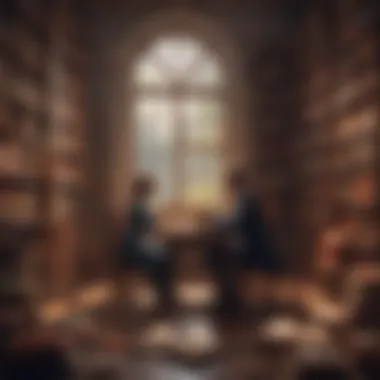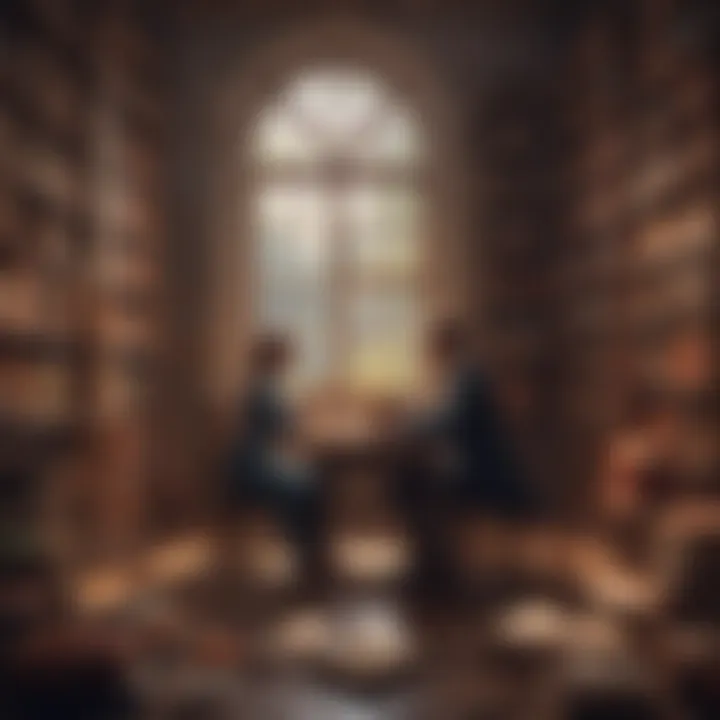Exploring Endearing Couples in Literature


Intro
Literature has a unique knack for bringing relationships to life in a way that resonates with us deeply. The stories we read often feature couples whose love transcends the pages, offering us glimpses into the most complex and charming dynamics. This article digs into the essence of these pairs, unveiling the narratives that have captivated readers across generations. Whether in epic romances or subtle, quiet connections, the way love is portrayed can profoundly shape our understanding of character motivations and drives within the story.
By examining some of the most celebrated literary couples, readers will see not only how their entanglements influence the plot but also what they say about the nature of love itself.
In exploring these couples, themes such as sacrifice, growth, and the intertwining of destiny and choice emerge, illustrating how relationships can be both a source of strength and a catalyst for conflict.
Key Themes Explored
Theme Highlights
When focusing on the connections between characters in literature, several key themes often rise to the surface:
- Transformation through Love: Many couples demonstrate how love can act as a transformative force, leading to personal growth and shifts in perspective.
- Conflict and Resolution: Relationships often face trials that serve to define the characters involved, but the resolution of these conflicts can offer powerful insights into the human condition.
- Cultural Influences: The background and societal norms play a crucial role in shaping the dynamics between couples. Literature often reflects and critiques these influences.
Relevant Quotes and Insights
"We were all fools to think that happiness was so simple."
— from a poignant work that highlights love's complexities
This quote exemplifies the intricate nature of romance portrayed in literature. The connections we observe often mirror the messiness of real-life relationships, underscoring the theme that love is rarely straightforward.
Actionable Takeaways
Practical Tips and Strategies
As readers, gaining a deeper understanding of these couples can enhance not only our appreciation of literature but also provide insights into our relationships:
- Reflect on Character Growth: Look for how each character evolves due to their partner's influence. This can reveal underlying themes of dependency and support.
- Analyze Conflicts: Pay attention to the conflicts that arise within the couple. What do these struggles reveal about societal norms or personal values?
- Consider the Influence of Setting: Examine how the time period, location, and cultural context shape the relationship.
Suggested Further Reading
To dive deeper into the theme of love in literature, consider these works:
- "Pride and Prejudice" by Jane Austen
- "The Great Gatsby" by F. Scott Fitzgerald
- "Wuthering Heights" by Emily Brontë
Each of these novels offers rich portrayals of relationships that challenge, inspire, and evoke deep emotional responses.
By unraveling the complexities within these endearing couples, readers gain not just enjoyment but also wisdom on love's many facets. Understanding these dynamics not only enriches our literary journey but also our approach to our personal relationships.
Defining the Concept of the Cutest Book Couples
When discussing literary couples, 'cutest' may seem a whimsical term, yet it carries a weight of significance. These endearing pairs don’t just exist to evoke smiles or warm the heart; rather, they play pivotal roles in the narratives they inhabit. By analyzing what defines a couple as ‘cute’ in literature, we can unearth deeper layers of character development, thematic exploration, and sociocultural reflection.
A couple’s appeal can stem from their quirks, how they complement each other, or the journey they undertake together. Whether sharing a misadventure, overcoming obstacles, or expressing love in delightful ways, these characters resonate with readers across ages.
The exploration here is not solely about romance but also the myriad ways it enhances the narrative. It provokes considerations: how do readers connect with these characters? What themes do they embody? Recognizing the cutest couples enriches our understanding of how love shapes both individuals and plots.
Cultural Context of Literary Romance
The depiction of romance in literature varies significantly across cultures and epochs. In many Western narratives, love often aligns with personal fulfillment and individualism. Think of Elizabeth Bennet and Mr. Darcy in Jane Austen’s Pride and Prejudice, where social status ultimately yields to genuine affection.
Conversely, Eastern literature may emphasize collective values, as seen in works like The Tale of Genji by Murasaki Shikibu, where romantic entanglements reflect societal roles and expectations. This cultural lens allows readers to appreciate the diverse expressions of love, from youthful infatuation to serene companionship. These nuances add color to the perception of ‘cutest’ couples, as cultural contexts shape their experiences and relationships.
Criteria for 'Cutest' Couples
Identifying the cutest book couples isn't merely a subjective endeavor; certain criteria can guide this exploration. Here are some elements that play a significant part:
- Chemistry: The spark between characters brings their relationship to life. Be it witty banter or shy glances, chemistry fosters a connection that readers can sense.
- Growth: Couples that evolve through their journey—facing challenges and learning together—often seem more relatable. Their path reflects real emotional development, making them easier to root for.
- Quirkiness: Unique characteristics or habits can endear couples to readers. Whether it's a penchant for peculiar tea blends or an odd shared obsession, these traits create memorable moments.
- Support: Relationships that portray mutual encouragement illustrate healthy dynamics. When characters uplift one another, it embodies an inspiring ideal of partnership.
- Narrative Significance: Couples that substantially influence the plot can elevate their status. Their choices and interactions often serve as catalysts for major events, highlighting love's central role in storytelling.
These elements combine into a tapestry that gives form to the concept of cute couples in literature. Understanding these nuances isn’t just for a good read; it’s about exploring how they reflect human emotions and social values.
Classic Couples That Captured Hearts
When we dive into the vast ocean of literature, certain couples stand out as the anchors of their stories. These classic couples not only reflect the societal norms and values of their time but also resonate with readers through their struggles and triumphs. The tales of love, conflict, and growth surrounding these characters evoke a sense of nostalgia and make them memorable, thus capturing the hearts of generations.
The allure of these classic couples lies in their emotional depth and complexity. Readers can often see pieces of themselves reflected in their challenges and joys. Whether it’s navigating societal expectations or grappling with personal demons, these couples embody the trials that many face in real life, allowing us to engage more intimately with their tales. With that said, let us explore a couple of these iconic literary pairs that have left an indelible mark on the literary landscape.
Elizabeth Bennet and Mr. Darcy
In Jane Austen's seminal novel, Pride and Prejudice, Elizabeth Bennet and Mr. Darcy emerge not just as a couple, but as icons of love that transcends prejudice and initial misunderstandings. At first glance, their differences seem insurmountable—Elizabeth, witty and opinionated, reflects the ideals of a more independent woman, while Darcy, aristocratic and proud, struggles with his own sense of worthiness. This initial clash of characters sets the stage for a narrative steeped in romantic tension.
The beauty of their relationship unfolds slowly, with layers of character development that challenge both Elizabeth's and Darcy’s perceptions. Darcy's transformation from aloofness to genuine love circles back to the theme of personal growth, prompted by the steadfastness of Elizabeth's spirit. As readers journey through misunderstandings and revelations, we witness how love flourishes amidst the thorns of class division and societal expectations. Their love story speaks to the power of self-awareness and vulnerability, ultimately pushing both characters towards a more profound understanding of each other and themselves.
Romeo and Juliet: A Timeless Tragedy
Often referred to as the quintessential love story, Shakespeare’s Romeo and Juliet epitomizes the sheer intensity and drama that come with youthful passion. The tragic fate of these star-crossed lovers illustrates love's capacity to inspire but also to devastate. Romeo and Juliet, despite coming from feuding families, ignite a romance that is as effervescent as it is doomed.
Their relationship is a poignant exploration of love's irrationality, where emotions outweigh societal obligations. The fervor and impulsiveness that characterize their attachment create moments that are both poetic and heart-wrenching. This passionate bond serves as a backdrop to the enduring themes of fate, loyalty, and the desperate desire for connection, creating an echo that resonates through the ages.
"For never was a story of more woe than this of Juliet and her Romeo."
The stark reality of their ultimate demise not only brings sorrow but also compels readers to reflect on the transient nature of love and the inevitable collision with fate.


In analyzing these classic couples, it becomes clear that their relationships are far more than romantic escapades; they embody essential human experiences, encapsulated by love, struggle, and the relentless pursuit of understanding. Each couple, though set against different backdrops of societal or familial conflict, urges readers to ponder the various facets of love and its potential for both joy and heartache. Whether it's the witty exchanges between Elizabeth and Darcy or the impassioned encounters of Romeo and Juliet, these classic couples remind us that the journey of love often holds as much significance as the destination.
Modern Romances That Inspire
In today's fast-paced world, modern literary romances resonate with readers in unique ways. The importance of exploring these relationships lies not just in their charm but also in their reflection of contemporary issues and emotions. By delving into modern romances, one can appreciate the nuances of love that capture the complexity of human experiences. These tales often depict a blend of individual aspiration with companionship, which can help readers relate to the characters in a more profound way.
Moreover, contemporary couples often navigate challenges that mirror the struggles faced by many, such as mental health, identity, and societal pressures. This connection allows readers to see themselves in the stories, making the romances not only entertaining but also impactful and, sometimes, transformative. Capturing these realistic elements opens the door for discussions around love in the current societal landscape.
Hazel Grace and Augustus Waters
Hazel Grace Lancaster and Augustus Waters, from John Green's acclaimed novel The Fault in Our Stars, embody a poignant example of young love intertwined with the harsh realities of life. Both characters are grappling with serious illnesses, yet their relationship blooms in the most enchanting way. Augustus, a charismatic young man, adds a spark to Hazel’s introspective nature.
Their chemistry is immediate, but what is truly compelling is how their love challenges them to confront their fears and desires. Rather than simply becoming a tale of romance, their story explores themes of mortality, hope, and resilience, presenting a more layered look at relationships.
"Some infinities are bigger than other infinities."
This quote from the novel highlights the significance of quality over quantity in love. Their time together, though limited, becomes a rich tapestry of shared experiences, illustrating how love can exist amidst tragedy. The emotional depth of their relationship not only engages readers but also encourages them to reflect on their own connections and life decisions in a way that feels authentic and relatable.
Cath and Levi from 'Fangirl'
In Rainbow Rowell's novel Fangirl, Cath and Levi represent a different yet equally meaningful brand of modern romance. Cath is a socially anxious college freshman who loves writing fan fiction, while Levi is an outgoing and friendly classmate who embodies a blend of understanding and support. Their relationship develops slowly, allowing room for character growth and authenticity.
Cath’s initial struggles with her self-image and dependency on fan fiction creates a backdrop of real-world issues. Levi respects her boundaries while gently pushing her to step out of her comfort zone. Their relationship emphasizes the importance of personal growth, making it a refreshing narrative in the realm of literary love stories.
This couple challenges stereotypes often found in romantic narratives. Instead of grand gestures and whirlwind experiences, their love story unfolds in everyday moments, fostering a deeper connection based on trust and friendship.
Both Hazel and Augustus, as well as Cath and Levi, remind us that modern romances can be as simple as they are complex, reflecting the varied dimensions of love today. Through their narratives, readers gain valuable insights into how personal struggles can shape relationships and ultimately enhance our understanding of ourselves and others in the journey of love.
Fantasy and Fiction: Couples in Imaginary Realms
When we dive into the fantastical worlds of literature, we encounter couples whose love stories transcend the boundaries of reality. In these imagined realms, the relationships not only add depth to the narrative but also serve as a lens through which readers can explore complex themes like sacrifice, identity, and destiny. Couples in fantasy and fiction often grapple with extraordinary challenges—be it dragons, curses, or moral dilemmas—yet their bonds often illuminate the very human experience of love.
The couples in these stories are not simply romantic interests; they represent ideals, struggles, and triumphs that resonate on a personal level. Through their interactions, authors tend to weave societal norms, emotional resilience, and individual growth, creating intricate dynamics that echo the multifaceted nature of relationships in the real world. In essence, fantasy and fiction become megaphones for exploring the depth of human emotions amidst wildly imaginative backdrops.
Katarina and Aylin in 'The Accidental Alchemist'
In "The Accidental Alchemist," we meet Katarina and Aylin, two characters from vastly different worlds. Katarina, a skilled but misunderstood alchemist, embodies the struggle of finding one's place within a chaotic environment. On the other hand, Aylin, a creature of magic and mystery, challenges societal norms and presents an exploration of friendship that evolves into something deeper.
Katarina's journey involves not only the pursuit of alchemy but also the quest for self-acceptance. Her relationship with Aylin serves as a catalyst for her transformation. Their bond exemplifies the idea that love can emerge from friendship, coupled with mutual understanding and respect. Part of what makes their relationship captivating is how they navigate the hurdles posed by their different backgrounds, each supporting the other's growth in the face of adversity.
This dynamic highlights a broader theme in literature: the impact of companionship on personal development.
"Their love is a blend of magic and reality, reminding us that sometimes, enchanting relationships can anchor us amidst turmoil."
Aelin and Rowan from 'Throne of Glass'
Aelin and Rowan, characters from Sarah J. Maas's "Throne of Glass," provide yet another striking example of love in a landscape filled with peril and intrigue. Their relationship develops within the backdrop of a fantasy realm, laden with both political intrigue and supernatural elements. Aelin, a fiercely independent assassin, encounters Rowan, a warrior prince bound by ancient curses and duty. Their love story unfolds with breathtaking intensity, showcasing the balance between vulnerability and strength.
Rowan's loyalty and strength complement Aelin's fiery spirit. Together, they challenge not only external foes but also the internal battles each faces in their journey to self-discovery. Their relationship is marked by a fascinating interplay of individuality; while they are indeed partners in love, they each maintain a strong sense of self. This balance between independence and togetherness is crucial, especially when navigating their treacherous world.
Aelin and Rowan thus symbolize a partnership built on mutual strengthening, trust, and deep emotional understanding. Their coupling resonates with readers by illustrating that love is not merely about being together, but also about continuing to grow as individuals, even when faced with the wildest of imaginations.
Diversity in Depictions of Love
The representation of love in literature holds a mirror to the shifting landscapes of society. The theme of diversity in relationships, encompassing different sexual orientations and cultural backgrounds, is crucial in understanding how love is portrayed across various narratives. It is significant not just for its artistic merit but also for the broader implications it has on readers’ perceptions of love and companionship.
Diversity in love stories offers readers a chance to see reflections of their own lives and experiences. This leads to greater empathy and expands the understanding of what love can look like, enabling readers to grasp the nuances of relationships that differ from dominant narratives. In addition to that, diversity within literary couples enriches the tapestry of storytelling by challenging societal norms and stereotypes. The exploration of varied partnerships within the literary canon illustrates that love transcends simple pairings, figuring instead into complex dynamics shaped by societal, cultural, and individual factors.
In the following sections, we will delve into same-sex couples and interracial relationships in literature, examining their development and significance to the genre as well as to audiences hungry for representation.
Same-Sex Couples in Literature
The evolution of same-sex couples in literature is a fascinating journey reflecting broader societal changes. Historically relegated to the margins, same-sex relationships have slowly been woven into mainstream narratives. Works like "Call Me by Your Name" by André Aciman and "The Price of Salt" by Patricia Highsmith (also known as Carol) have given voice to the complexities and beauty of love between individuals of the same sex.
Literature that features same-sex couples often serves as a powerful commentary on identity and acceptance. These stories address the struggles faced by LGBTQ+ individuals while showcasing the beauty of love that defies norms. For example, the dynamic between Elio and Oliver in "Call Me by Your Name" is not just about romantic love; it is about self-discovery and longing. Such narratives highlight how relationships can foster growth and understanding in environments that may not always be accepting.
Moreover, these literary couples provide a sense of validation for readers who identify with their experiences. Through their stories, readers often find reaffirmation of their identity and relationships, helping to counteract stereotypes and stigmas that have persisted in society.
Interracial Relationships in Novels
Interracial relationships in novels introduce readers to a rich blend of cultural perspectives and emotional conflicts. These couples navigate personal and societal biases, leading to discussions about race, identity, and acceptance. Examples like "The Wedding
The Role of Conflict in Romantic Narratives
Conflict serves as the bedrock upon which the narratives of love are constructed. In literature, conflict is not mere chaos, but rather a catalyst that propels characters toward deeper understanding, growth, and resolution. It exposes vulnerabilities and lays bare the true nature of relationships. Couples in literature often traverse a landscape fraught with misunderstandings, societal pressures, and personal struggles.
Through the lens of conflict, we can examine how it shapes the course of romantic relationships. The friction that arises—the disagreements, the secrets, the unmet expectations—becomes instrumental in defining the characters’ personalities and, by extension, the story itself. In essence, conflict reveals the very essence of love, as it forces characters to confront not only their partners but also themselves.
"Conflict is the heartbeat of every story; without it, love would merely float aimlessly."
Characters must navigate these rugged terrains with a sense of resilience. Their journeys speak volumes about the nature of human connection; they exhibit that real love is not just about harmony but also about reconciliation and understanding after tumult.
Misunderstandings and Growth
Misunderstandings are particularly pivotal in romantic narratives. They underline the fact that love cannot exist in a bubble; it requires communication and effort. Often, characters misinterpret their partner’s intentions or fail to express their feelings effectively. These gaps can lead to profound character development.


For instance, take Elizabeth Bennet and Mr. Darcy from Jane Austen's "Pride and Prejudice." Their relationship is riddled with misinterpretations and societal expectations. Initially, Darcy's aloofness is perceived as pride, while Elizabeth's prejudices lead her to misjudge him. It is through these misunderstandings that both characters grow; they embark on a journey of introspection, ultimately leading to a more profound connection. Such narratives emphasize that misunderstandings, as frustrating as they may be, are fertile ground for character development and relational depth.
- Misunderstandings often lead to:
- Character introspection: Characters reassess their beliefs and feelings.
- Evolving dynamics: The relationship dynamics shift as characters react to misunderstandings.
- Narrative tension: Adds urgency and stakes to the story, engaging the reader.
Balancing Conflict and Resolution
Finding equilibrium between conflict and resolution is a delicate dance in romantic narratives. While conflict can create tension and depth, too much can sour the reader’s experience. Therefore, authors often strive to balance these elements, allowing characters to confront their issues while also offering moments of clarity and love.
Successful resolution is often not about tying every loose end with a neat little bow. It involves growth and understanding that arises from struggles, allowing the characters to emerge as more rounded individuals. A powerful example of resolving conflict can be seen in the evolving relationship of Augustus and Hazel from John Green’s "The Fault in Our Stars." Their love flourishes amid the undeniable tensions brought by their circumstances, ultimately leading to profound insights about life and love before they part ways.
- Effective resolution strategies in stories may include:
- Honest dialogue: Characters communicate openly about their challenges.
- Mutual growth: Both partners evolve due to their experiences together.
- Reflective moments: Characters have moments of solitude to process their feelings.
In summary, the role of conflict in romantic narratives is multifaceted. It challenges characters and fosters growth, enriching the broader narrative. By navigating misunderstandings and balancing tensions with resolutions, couples in literature not only survive but thrive, offering readers valuable insights into the intricacies of love.
Symbolism of Love in Literature
Love in literature is often depicted through symbols that resonate deeply with readers. Rather than merely presenting romantic connections at face value, the use of symbolism enriches the narrative, allowing themes of affection, longing, and intimacy to unfold in more complex and engaging ways. By understanding these elements, students, professionals, and avid readers can appreciate the layers of meaning infused into stories, encouraging a more profound connection to the material.
Nature and the Elements
Nature frequently serves as a powerful backdrop and symbol for love in literature. Several elements can represent different aspects of a romantic relationship. Flowers, for instance, are a classic symbol, with roses denoting passion and love, while daisies often represent innocence. Each blossom suggests a specific emotion or stages of a relationship. Beyond flora, other facets of nature also act as metaphors for love.
- The Ocean: Often signifies depth and vastness of feelings. Characters may meet by the sea, where the tides reflect the ebb and flow of their relationship.
- Mountains: Can symbolize the challenges lovers face, while also representing stability and permanence in a bond.
In many tales, the seasons change alongside the characters’ emotional journeys. Spring might evoke renewal and new affection, while autumn represents the bittersweet nature of love’s impermanence. This interplay between nature and romance amplifies emotional resonance, adding lyrical beauty to otherwise mundane moments.
"Love is like the sun; its persistent warmth brightens even the darkest of days."
Objects as Symbols of Affection
Objects in literature serve not just as mere props but often act as profound symbols of affection between characters. Each item may carry history, memories, or meaning that illustrates the depth of relationships.
For example:
- Letters: These written tokens often represent longing, communication, and emotional connection. When characters exchange letters, it embodies the process of getting to know one's feelings and intentions. Think of the heart-wrenching correspondence in The Fault in Our Stars.
- Gifts: An object given in love often reflects the feelings of the giver. A handmade bracelet might symbolize dedication, while a book can signify shared interests and intellectual connection.
- Traditions: Certain items can embody heritage and shared culture, like a special family recipe, crafting ties across generations, thus adding layers to a romantic narrative.
In essence, through careful attention to what these objects symbolize, readers can uncover deeper meanings and emotional threads woven into the fabric of literary love stories.
Understanding the Dynamics of Relationships
In literature, the portrayal of relationships often revolves around the intricate interplay of love, companionship, independence, and unity. This section examines the dynamics that underpin enduring literary relationships, diving into the fabric of how characters grow individually and together. Understanding these dynamics sheds light on the caprices of love and the multifaceted nature of human interactions.
A successful relationship in literature usually does more than just tell a love story; it reflects the complexity of real-life partnerships. Through the lens of fictional couples, we explore how independence and interdependence shape identities and create resonances within the narrative. Moreover, the way characters communicate – or fail to do so – lays bare both their vulnerabilities and strengths. Let's delve deeper into these elements to appreciate the rich tapestry of relationships in literary works.
Balancing Independence and Interdependence
Independence and interdependence often walk hand in hand in strong literary couples. Each partner brings their own strengths, interests, and quirks to the relationship, allowing both to flourish individually. For instance, one can consider Elizabeth Bennet and Mr. Darcy from "Pride and Prejudice." Throughout the narrative, Elizabeth maintains her independence, often challenging societal norms while still cultivating a deep bond with Darcy.
This balance is not just about sharing love but also about understanding personal aspirations. When characters like Hazel Grace and Augustus Waters from "The Fault in Our Stars" support each other's dreams while battling own challenges, it highlights a significant truth in relationships: the synergy of personal growth and mutual support.
- The independence nurtures personal identity.
- The interdependence creates a stronger emotional bond.
- Balancing both fosters mutual respect and understanding.
Communication in Romantic Partnerships
Effective communication goes beyond mere words; it is the lifeblood of relatable and realistic romantic partnerships in literature. The way characters express themselves reveals their emotional depth and helps define their relationships' trajectory. Take for instance the delectable conversations and misunderstandings between Cath and Levi from "Fangirl." Their journey showcases how timely, honest communication can bridge gaps, reinforcing connections rather than allowing them to fray.
However, miscommunication can lead to conflicts that drive the plot forward. It's this push and pull, where characters like Aelin and Rowan from "Throne of Glass" navigate through misunderstandings before reaching clarity, that adds depth. It's a reminder that communication isn't just about talking; it’s about listening, understanding, and growing together.
"The most important thing in communication is hearing what isn't said."
– Peter Drucker
By emphasizing open dialogue and mutual respect, literary couples often illustrate how communication is pivotal in developing a resilient partnership.
In summary, the dynamics of relationships shaped by independence, interdependence, and effective communication not only animate characters but also invite readers to reflect on their own relationships. This understanding enhances the emotional weight of these couples, allowing readers to connect on a deeper level.
Influence of Societal Norms on Relationships
The exploration of couples in literature cannot be complete without examining the impact that societal norms have on romantic relationships. These norms often dictate how love is expressed, who can love whom, and even the longevity of romantic bonds. In literature, these influences shape not only the characters but also the narrative arcs, reflecting the broader cultural attitudes of their time. Understanding this influence adds depth to our appreciation of literary couples, allowing us to see them as products of their environment rather than just romantic figures.
Societal norms are often a double-edged sword. On one hand, they provide a framework that can unite lovers and offer a sense of belonging. On the other hand, they can create barriers and expectations that stifle individuality and authenticity in relationships. This dichotomy often drives the tension in romantic narratives, making them richer and more engaging.
Expectations and Reality in Love
The gap between what society expects from couples and the actual experiences they have is a recurring theme in literary love stories. Readers frequently encounter couples dealing with the weight of external expectations. This tension can be seen vividly in Jane Austen's novels, where characters often grapple with societal dictates about class and propriety.
- The Class Divide: In Pride and Prejudice, Elizabeth Bennet and Mr. Darcy face societal judgement due to their differing social standings. This creates a rich backdrop for their relationship, highlighting the struggle between individual desires and societal norms.
- Cultural Pressures: In The Joy Luck Club by Amy Tan, the generational divide showcases how cultural pressures affect the romantic choices of young women, resulting in complex emotional landscapes filled with conflict and understanding.
This illusion caused by societal expectations can lead to poignant moments where characters must choose between personal happiness and societal acceptance.
Changing Narratives of Romance


As societies evolve, so do the narratives surrounding love and relationships in literature. The changing landscapes allow for fresh perspectives on what romance can look like. This evolution can be seen through various genres and time periods; for instance, romantic partnerships portrayed in contemporary literature often challenge existing stereotypes.
- Breaking Traditional Molds: In Call Me by Your Name by Andre Aciman, the relationship between Elio and Oliver defies conventional norms, showcasing an intense, yet delicately woven romance that speaks to a more modern understanding of love.
Consider how the stories in today’s literary scene often challenge established norms: Same-sex couples, interracial relationships, and non-traditional family structures are more frequently depicted, offering a broader spectrum of what love can represent.
These shifting narratives allow readers to engage with stories that reflect their own experiences, thus creating a deeper emotional connection with the text.
In essence, societal norms shape the fabric of relationships in literature. They get woven into the lives of characters, offering insight beyond the text itself, inviting readers to reflect on their own romantic ideologies and experiences. The evolution of these norms not only enriches storytelling but broadens our understanding of love in various contexts.
Romantic Archetypes in Literature
Romantic archetypes serve as a fundamental element in literature, offering a framework through which authors convey the nature and complexities of love. Understanding these archetypes not only enhances our appreciation of narratives but also provides insight into character motivations and emotional dynamics. The exploration of these patterns can illuminate the nuances of relationships, revealing how they shape the stories they are woven into.
Literature is populated with archetypes that resonate deeply with readers, and they often reflect societal values and norms regarding romance. By identifying and analyzing these tropes, readers can gain a deeper understanding of different portrayals of love and how these narratives can transcend time and culture. Archetypes also allow for a connection to personal experiences, making readers feel like they know these characters intimately, as if their stories echo their own romantic journeys.
In this section, we will delve into two popular archetypes: The Star-Crossed Lovers and The Opposites Attract Scenario. Each of these archetypes provides unique lenses through which to explore love and connection in literature, as well as the broader implications they carry.
"The heart wants what it wants, and often it is a lesson in contrasts."
The Star-Crossed Lovers
The term "star-crossed lovers" refers to couples whose love is doomed to fail due to external forces, fate, or circumstances beyond their control. This archetype is one of the oldest in literature, widely recognized through works like Shakespeare's Romeo and Juliet. Here, the essence of their love lies not just in its intensity but also in the insurmountable barriers they face, such as family feuds or societal expectations.
The significance of star-crossed lovers rests in their emotional resonance. They often symbolize passion and idealism, coupled with the tragedy of loss, making their stories compelling to readers. The lovers become archetypes of yearning — a visceral reminder of how love can be both a joy and a source of heartache. Their narratives delve deep into themes of sacrifice, destiny, and the human condition.
This archetype frequently challenges conventional notions of love. It raises questions about fate, free will, and the cost of love against the backdrop of societal constraints or family loyalties. It asks readers to ponder whether love can withstand adversity or if it is ultimately futile against the tides of destiny.
The Opposites Attract Scenario
Conversely, the opposites attract scenario showcases lovers with contrasting personalities, backgrounds, or beliefs coming together to form unexpected relationships. This archetype thrives on conflict and chemistry, providing a rich ground for character development and narrative tension. Classic examples include Elizabeth Bennet and Mr. Darcy from Pride and Prejudice, where initial misunderstandings blossom into deep affection despite their differences.
The beauty of the opposites attract narrative lies in its ability to highlight growth. Through their differences, characters often learn valuable lessons about acceptance, compromise, and the importance of seeing the world through another’s eyes. This dynamic can also redefine traditional gender roles and social expectations by presenting varied perspectives on love and relationships.
Another intriguing aspect is how this archetype can serve as a mirror to society. It highlights the power of love to bridge divides and foster connections between seemingly incompatible individuals. Furthermore, it invites reflection on the complexities of human nature and the myriad of factors that can unite us despite our distinctions.
Emotional Impact of Literary Couples
When we turn the pages of a novel, we enter a world where relationships evolve and unfold, often reflecting our deepest desires and fears. The emotional impact of literary couples extends far beyond mere entertainment. It offers us reflections on our own lives, influencing how we approach love, trust, and companionship.
Literary couples embody a range of emotions—joy, heartbreak, desire, and sacrifice. They bring to life the complexities of human relationships, and through their journeys, readers can often find echoes of their experiences. This connection is what makes the exploration of these couples so engaging and meaningful.
Resonance with Readers
Literary couples serve as a mirror to the reader's feelings and experiences. When we read about Hazel Grace and Augustus Waters from The Fault in Our Stars, their struggles with terminal illness and the intensity of their love hit home for many, creating a visceral response. Readers find themselves rooting for these characters because their joys and pain resonate deeply, often transporting us back to our own bittersweet memories.
Moreover, the emotional arcs of these couples provide relatable scenarios. For example, Elizabeth Bennet and Mr. Darcy in Pride and Prejudice explore themes of class, pride, and identity. The reader navigates through misunderstandings alongside them, feeling the weight of their regrets and the sweetness of eventual resolution.
We often see this resonance manifest in various forms:
- Relatable Experiences: The way literary couples face challenges often reflects real-life dilemmas.
- Vicarious Emotions: Readers experience joy, grief, and love through the lives of these characters without fearing the consequences. This catharsis is invaluable.
"Literature provides us a chance to experience emotions in a safe space; we laugh, we cry, we feel. Yet, we do so from a distance."
Transformative Effects of Love Stories
The transformative nature of love stories cannot be understated. They have the power to change characters and, by extension, influence readers. The journey through love often leads characters to significant personal growth and reflection, a process that readers can learn from as well. Take Aelin and Rowan from Throne of Glass; their fierce loyalty and the trials they endure forge them into leaders who learn to balance passion with responsibility. This evolution impacts how readers perceive love and relationships.
Every transformed character leads us to new insights about ourselves and our world. The emotionally charged situations faced by couples compel us to think more critically about our own relationships.
- Resilience and Healing: Love stories often showcase the power of love to heal, as characters work through their issues.
- Understanding Unconditional Love: Characters like Hazel and Augustus encourage readers to appreciate love that transcends struggles, showcasing both fragility and strength.
These narratives not only entertain; they offer us lessons on empathy, understanding, and the myriad ways love can shape a life. The impact of their stories lingers long after we've closed the book, constantly inviting us to reassess our own views on love and connection.
Concluding Thoughts on Literary Relationships
Literary relationships are more than mere interactions between characters; they are the heartbeats of narratives, the threads that weave plots into cohesive wholes. The exploration of these relationships yields insights that go beyond the text, revealing how love shapes characters and drives stories forward. In the context of this article, understanding the culmination of these dynamics can enhance the reader's appreciation of literature itself.
The significance of literary couples lies not just in the romance they depict but in the lessons of compassion, growth, and emotional understanding they convey. They offer windows into the human condition, beckoning readers to reflect on their own experiences and relationships. Whether through tragic love stories or uplifting partnerships, these characters serve as mirrors, often reflecting our deepest desires, fears, and aspirations.
"Literature is a powerful tool for empathy, showing us lives we might never have lived, through the lens of love and companionship."
The Lasting Influence of Book Couples
The impact of beloved couples in literature often extends outwards, influencing cultural perceptions of love and relationships. Readers find themselves formed and transformed by these narratives. The connections forged between characters can spark emotional resonances that linger long after the book is closed.
Consider the fondness many have for Elizabeth Bennet and Mr. Darcy; their journey from pride and prejudice to understanding and love has become a metaphor for overcoming personal shortcomings. This enduring story has shaped societal views on marriage and individual autonomy, encouraging readers to seek compatible partnerships.
Similarly, contemporary couples like Hazel Grace and Augustus Waters bring to the forefront modern themes of love's fragility. The resonance of their relationship, built against a backdrop of illness, challenges readers to confront difficult emotions and appreciate love in its myriad forms.
- Timeless relevance: These couples reflect evolving societal norms, adapting to changes while maintaining core values of love, loyalty, and understanding.
- Cultural benchmarks: They become symbols for aspirational ideals, setting benchmarks for emotional connections in real life.
Encouraging New Perspectives on Love and Relationships
Through the vivid portrayals of literary couples, readers are often pushed to expand their own conceptions of love. Stories highlight that love is not merely a romantic endeavor; it can portray friendship, familial bonds, and community connections. The narratives urge us to consider the many facets of relationships and challenge us to think critically about how love manifests in different forms.
Authors utilize diverse couple scenarios—from same-sex relationships to interracial romances—to underscore that love is a universal language.
In reading about these varied depictions, individuals gain insights into experiencing love and acceptance in their own lives. It paves the way for recognizing that just as characters sometimes struggle to find their place, so too can real people. Literature can remind us that love isn't an end goal but an evolving journey filled with experiences that shape who we are.
- Broadened horizons: Reading about complex relationships encourages empathy and understanding.
- Lessons on resilience: Characters overcoming adversity together can inspire readers to face their own challenges in relationships.















